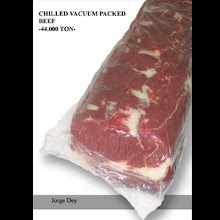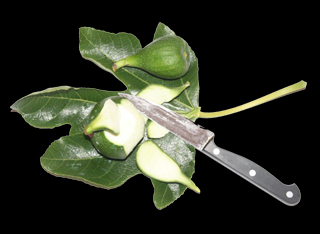Chilled vacuum packed beef -44,000 tons- is a simple clear handbook appropriate for those who wish to learn about the production process of chilled meat. As well as explaining the normal process of vacuum packing, it explains possible deviations of the process. The detailed index of the book can be found at the following blog of the English version44,000 TON-
The author controlled the quality of 44,000 tons of vacuum-packed chilled beef exported during 1989-2006. He took into account the technical-practical point of view of the process without going deeply into microbiological and organoleptical studies.
This book contains an index of the possible problems that might be found during the production process.It will enable the reader to find the section in which the likely cause of the problem is dealt with.
Author: ➤Jorge Dey
Veterinarian graduated from the University of La Plata, Argentina.
He has worked in the meat industry since 1982.
English version translated by: ➤Roy Attree Dey
Specialist in the meat industry. He worked in the meat industry from
1955 to 2006.
Both authors have been responsible for the quality of more than
44,000 tones of Hilton beef exported to Maredo-Transmeat for the
European markets between 1989 and 2006.
Introduction.
This book is the one that I would have liked to read when
I started to work in the Meat Industry, since it would have
helped my orientation in the process of chilled beef. I
believe it will help all those who wish to know more about
the subject.
It has been written only as a point of practical technical
view of the process without going into profound
microbiological or organoleptical studies.
Roy Dey translated the English version with total liberty.
Index
Introduction
A quick look at history
➤The object of vacuum packing.
1. Primal Packing.
2. Vacuum.
3. Fundamental factors to take into account in obtaining vacuum.
3.1. The bag.
3.1.1 Size of bag.
3.1.2 Bag film and its permeability
3.1.3 Perforations on the surface.
3.1.4 Mayor perforations.
3.1.5 Micro perforations.
3.1.6 Scorching.
3.1.7. Closure of bags by producer.
3.2. The vacuum.
3.3 The sealing or closure of the plant.
3.4 Temperature of the meat.
3.5. Presence of humidity.
3.6 Temperature of the meat and presence of bacteria.
3.7 Size of cut.
3.8. PH of the meat.
4. Thermo-contraction of the bags.
4.1 Process of thermo-contraction.
4.1.1 Air shrinking
4.2.2 Water shrinking.
5. The drying of bagged cuts
6. Secondary pack.
6.1 The carton, reinforcements, polythene film.
6.2 The packing of the bagged cuts.
6.3 Weighing and marking of cartons.
6.4 Closure of cartons.
7. The stowage in chambers.
8. Loading of container.
9. Maturing of packed cuts and the importance of PH in its process
10. Minimum controls to bear in mind in the process.
10.1 During production
10.2 The following days (24 to 48 hours).
10.3 Pre shipment
11. Faced with a vacuum claim in destination.
11.1 Minimum requirements to be requested from customer.
12. The use of bags for frozen products.
Glossary.
Index of possible problems.
Damaged bags to lose complete vacuum 3.1.4
Bags that maintain their vacuum while not suffer movement 3.1.4
Baged product with areas of red colour 3.1.5
Bags with scorching areas 3.1.6
Vacuum loss bags with noon crystal areas. 3.1.6
The closure of the manufacturing breaks or opens 3.1.7 and 6.1
Bags with poor vacuum 3.2 and 11.
Bubbles in the sealed bags 3.2 and 11.
Packed cuts with bubbles of a reddish coloration 3.2
Sealed areas that burn and permit filtration 3.3
Sealing, that generate weak areas of the bag 3.3
One of the sealing is not complete 3.3
The presence of creasing in the sealed area 3.3
Dirty sealing 3.3
Closure is pulled, the bag will open 3.3
The bags that do not out turn completely vacuumed 3.2, 3.4, 3.5 and 3.6
Excess bubbles or a sudden presence of bubbles 3.6 and 11.
Bags have inflated 3.6
Bags with product in state decomposition 3.8 and 9.
Bags without thermo contraction 4.1
Bags with that thin brown colour on the surface 4.2.2
Bags with cuts with stains grey on surfaces 3.1.2
Bags with grey gelatine lines with bad smell 4.2.2
Cartons opened with bad smell 5
Bags with an excess of juice.7
Bags that leak juice and vacuum 12.
Bags that the film separates into layers 3.1.2
Collapsed cartons at the back of the container 8
Jorge Dey was born in Argentina in 1956. He graduated as a veterinarian at the National University of La Plata.
He started work in the meat industry in 1982 specializing himself in quality control.
He has always dealt with the technical-practical aspects, always minding the commercial area, both in Argentine and foreign companies.
He has had the opportunity of working in several countries in the world comparing the different techniques used there, among them New Zeland, Russia, Ukraine, Ecuador, Brazil, Paraguay, Uruguay and Venezuela.
I would like to thank the great many people that have transmitted
their experiences to me all along these years, among
them my first teacher Roy Dey. All I have learnt from them,
both their right and wrong concepts, have been enriching.
Special thanks to my wife Cecilia, who always encouraged
me to carry on with this project.
ISBN: 978-987-22549-2-6
© 2008 by Jorge Dey
Editor: Salguero 2577 CP 1425 C.A.B.
Tel: 54-11-4806-6862
Editor: diemvers@yahoo.com
Autor: deyjorge@gmail.com
✯ How to get the book
✯ The object of vacuum packing beef
✯ Phrases translated by friends and readers.

